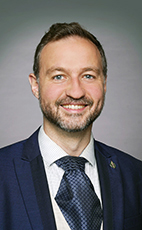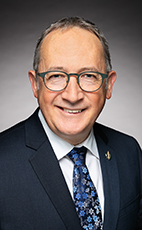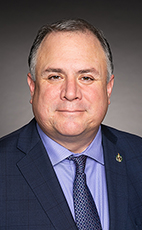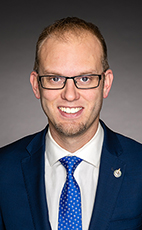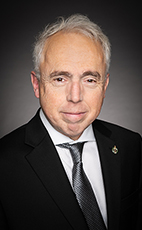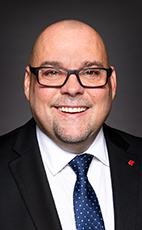44th Parl. 1st Sess.
May 18, 2023 10:00AM
- May/18/23 10:14:16 a.m.
- Watch
moved:
That, given that,
(i) Canada is in the midst of an opioid crisis that has killed over 35,000 people since 2016,
(ii) since 2017, the federal government has spent over $800 million on its failed Canadian Drugs and Substances Strategy, including over $100 million in funding for hard-drug supply projects across Canada, and plans to spend an additional $74 million to “scale up” these projects over the next five years,
(iii) since tax-funded drug supply was ramped up in 2020, opioid deaths have only gone up, according to the Public Health Agency of Canada,
(iv) in 2020, slightly less than 7,000 people died of opioid overdoses, while only 3,000 died of overdoses in 2016, according to the Library of Parliament,
(v) in British Columbia alone, yearly drug overdose deaths have increased by 330% between 2015 and 2022,
(vi) recently, a Global News reporter in East Vancouver was able to buy 26 hits for $30 in just 30 minutes of a dangerous and highly addictive opioid that is distributed in tax-funded drug supply programs and flooding our streets with cheap opioids,
the House call on the government to immediately reverse its deadly policies and redirect all funds from taxpayer-funded, hard drug programs to addiction, treatment and recovery programs.
He said: Mr. Speaker, I will be splitting my time with the hon. member for Cumberland—Colchester.
After eight years of the Prime Minister, everything feels broken. Life costs more. Work does not pay. Housing costs have doubled. The Prime Minister divides to control the people. Worst of all, crime and chaos, drugs and disorder rage in our streets. Nowhere is this worse than in the opioid overdose crisis, which has expanded so dramatically in the last several years.
The Prime Minister has a theory, backed up by a group of activists, most of them tax-funded, pharmaceutical companies and others that stand to gain from perpetuating the crisis. The theory is that, if the government provides powerful, heroin-like drugs that are uncontaminated, addicts will no longer use more deadly fentanyl, they will practise safe drug use and we will no longer have overdoses.
The Prime Minister has spent $78 million on 28 projects giving out free drugs. His recent budget proposes another $100 million for more tax-funded drugs. This includes heroin dispensary machines, where people can walk up, press some buttons and heroin pops out. It also includes prescriptions that allow people to take hydromorphone out into the street and use it or sell it, however they like. The theory is that this would divert away from more dangerous fentanyl. Let us look at the facts.
This is fact number one: Since the Prime Minister took office, there have been more than 34,000 apparent opioid overdose deaths. Here is another fact: This is not a problem the Prime Minister inherited; it is one he helped create. A total of 5,360 apparent opioid overdose deaths occurred from January to September 2022. This is approximately 20 deaths per day. It is a 173% increase from 2016, the first full calendar year he was in office. In other words, since his policies have come into effect, the overdose numbers have nearly tripled.
This is fact number three: While the deaths have risen across the country under the Prime Minister's policies, they have been the very worst in those provincial and municipal jurisdictions that have most enthusiastically embraced them. For example, in British Columbia, where in most jurisdictions, particularly Vancouver, all three levels of government have endorsed the so-called safe supply and decriminalization of hard drugs, the levels of overdose deaths have been the highest. Across B.C., the number of overdose deaths is up 330%.
The COVID excuse no longer works. This is a fact: Despite the claim, by supporters of handing out and decriminalizing drugs, that COVID was to blame for the crisis, what we have seen is that, as COVID moves farther away in the rearview mirror, the overdose deaths actually increase. For example, in March of this year, we had 9% more overdose deaths in B.C. than in March 2022, and 23% more overdose deaths than in March 2021. The more we move away from COVID, the more the overdose deaths increase. In fact, the deaths are not coinciding with COVID. They are coinciding with the recent decriminalization of crack, heroin, fentanyl and other hard drugs on January 1.
We are told that all the experts agree, just like the Liberals tell us all the time whenever they do something that defies common sense. We remember that all the experts agreed that printing money would not cause inflation, right before it led to a 40-year high, or that catch-and-release bail would not increase crime rates, before crime skyrocketed 32%.
We are told that giving out and decriminalizing hard drugs would reduce drug overdoses. These so-called experts are typically pie-in-the-sky theorists with no experience getting people off drugs, or they are members of the “misery industry”, those paid activists and public health bureaucrats whose jobs depend on the crisis continuing.
The real academic scholarship is clear, if the minister would even bother to read it. A thorough study by dozens of doctors and researchers from Stanford University, published in The Lancet and shared by a former adviser to President Obama, found that:
At the same time, evidence clearly shows the folly of assuming that population health inherently improves when health-care systems provide as many opioids as possible with as few possible regulatory constraints as possible. Policies that should attract scepticism include dispensing of hydromorphone from vending machines and prescribing a range of potent opioids and other drugs (eg., benzodiazepines, stimulants) to individuals with OUD in hopes of creating a safe addictive-drug supply and eliminating the supervision of methadone patients—ie, converting the system to unmonitored, long-term prescriptions on a take-home basis.
The study goes on to comment on the claim that hydromorphone, which is what the government is giving out, is safe. It continues:
Although expressed from a public health viewpoint, these messages echo the opioid manufacturers in presuming that unrestricted opioid provision can only improve public health. The faith of some advocates that opioids are safe as long as they are not derived from illicit markets is impossible to reconcile with the hundreds of thousands of overdose deaths from legal, pharmaceutical grade opioids that preceded the introduction of fentanyl into U.S. and Canadian heroin markets.
Furthermore, the safe supply program uses hydromorphone, which, according to one study published in a pharmacology journal, “produced similar subjective and physiological effects as heroin, but was more potent than heroin.” This is the stuff the minister and the Prime Minister are giving out using our tax dollars.
In a 2020 podcast, Dr. Mark Tyndall, one of Canada's earliest safer supply advocates, said that he had tested the urine of 15 patients who were on safer supply and found that 90% of them used fentanyl. In other words, they were not being diverted from fentanyl; they were using it in conjunction with safer supply. Now we know that it is even worse than that; the hydromorphone is being resold by the user to children, and the profit is being reinvested in buying fentanyl. In other words, the government is not only giving out dangerous hydromorphone but also actually, in effect, giving out fentanyl by giving the user the hydromorphone to sell to raise the revenue to buy fentanyl. The government is using our tax dollars to give out fentanyl on our streets and cause this crisis. Meanwhile, the cost of a hit of hydromorphone has dropped by between 70% and 95%, to roughly a dollar a hit, because the government is effectively paying for it and handing it out far and wide.
This makes no sense. The facts and evidence disprove it as a strategy. This is a radical and out-of-touch approach, which is not aligned with that of any other successful jurisdiction in the world. It is quite the opposite of what is being done in places like Portugal, which has focused on recovery, not on handing out free hard drugs. Therein lies the hope. We can turn the hurt the Prime Minister has caused into the hope Canadians need.
In Alberta, which is thoroughly rejecting the decriminalization and tax-funded handout of hard drugs and instead putting the money into recovery, we have seen, in the most recent data, a 30% reduction in the number of overdose deaths. That is because it is clear that what people suffering from addiction need is help getting off the drugs. To have that, we need recovery communities where they can go to get help with breaking the addiction and, if necessary, be given a bit of medication to relieve the side effects of getting off the drug, and then have the psychotherapy necessary to overcome the underlying reasons they got into drug addiction in the first place. We know this works. The evidence backs it up.
Therefore, our common-sense plan is to take the money away from subsidizing heroin-like drugs, and instead put all that money into recovery and treatment and sue the powerful pharmaceutical companies that helped cause this crisis, so we can use the proceeds of that lawsuit to fund even more recovery. That is how we are going to bring home our loved ones drug-free. It is how we will turn hurt into hope. It is the common sense of the common people, united for our common home: their home, my home, our home. Let us bring it home.
1625 words
- Hear!
- Rabble!
- add
- star_border
- share
- May/18/23 10:26:23 a.m.
- Watch
Mr. Speaker, I thank the leader of the official opposition for his contribution to the debate.
However, I think things have gone a little too far. I am hearing terms that smack of demagoguery, unfortunately. The very wording of this motion signals a very aggressive, very warlike approach.
Maybe we could look at how other places address this issue and see what is working. The United States is one country known for adopting a warlike, combative approach instead of treating this like a social and public health problem. What has the outcome been there? Opioid deaths rose from about 50,000 in 2015 to nearly 100,000 in 2021.
Why not take a social and public health approach to the issue instead of such an aggressive one?
127 words
- Hear!
- Rabble!
- add
- star_border
- share
- May/18/23 11:12:40 a.m.
- Watch
Mr. Speaker, we in the Bloc Québécois view the opioid crisis as a public health issue, and we believe in a supportive approach. Yes, there are times when these individuals must be allowed to transition to a safe place with what we call a safe supply. There is no harm in that. My concern is that the terms used in the motion are judgmental.
I am also concerned about the fact that when I very calmly and politely asked my Conservative colleague a question and challenged the Conservative stance, he responded by saying, “Shame on this member”.
I would therefore like to take this opportunity to ask the Liberal member a question. At least I can probably count on an answer other than, “Shame on you”. How can we reach a balance? When it comes right down to it, the Conservatives' intentions are not all bad. That is not what I mean. They want to offer more services and to offer therapy. A balance between the two remains to be found. I would like the member to share her thoughts with us.
How can we balance support for drug use in public spaces against the urgent need to help these individuals break free from this vicious cycle? Ultimately, we all share the same goal.
222 words
- Hear!
- Rabble!
- add
- star_border
- share
- May/18/23 11:16:34 a.m.
- Watch
Mr. Speaker, first, I would like to note that I will share my speaking time with my passionate, interesting and capable colleague from Longueuil—Saint-Hubert.
Talking about drugs and their repercussions is not an easy topic for me. It is not easy because I quickly become emotional. When I do not want to be emotional, I get into data and statistics, so I distance the heart from the head. It is not easy because there are people from my past who will no longer be in my present or my future. Yes, it is a topic that is important to me. I need to find a middle ground in all this. Clearly, this morning, I did not find it, but it will be fine.
A full picture of the situation is needed to be able to act properly. The purpose of pilot projects is to obtain data, among other things. The opioid crisis is not a partisan issue or an issue that should become partisan. It is not the type of issue where the terms “me” or “my party” can be used. It is the type of issue that requires phrases like: “together, we succeeded”.
I will briefly recap the data reported in the media while adding a few caveats and stating the purpose of pilot projects and safe supply programs.
The date included in the Conservative Party's motion are true. I will not review them all. The opioid crisis kills 20 people per day.
Since 2016, over 34,000 people have died. Almost all the deaths were accidental. These are people who were supplied by the black market with products that those people did not even know contained fentanyl. In 88% of cases, the deaths involved adults aged 20 to 59, people in the prime of life.
Prior to the pandemic, 10 people per day died of an opioid overdose. That increase may be the result of mental health problems that were exacerbated by the distress experienced during the pandemic.
I heard my Conservative colleagues say that the pandemic has passed. Just because the pandemic has passed does not mean the distress has passed. Just because the pandemic has passed does not mean the addiction has passed.
In the media, it was noted that people were taking hydromorphone to sell it and then buy fentanyl on the black market. Are all hydromorphone users doing that? The answer is no. How many are reselling hydromorphone? We still do not know. I hope it will be possible to find out through the pilot projects and the data collected.
The black market exists because people cannot access something legally, no matter what it is. However, on the black market, it is impossible to control either the amount or quality of drug hits. That is the main problem.
People who become addicted leave the health care system, even if they can function day-to-day. These people quietly leave the system because they will not tell their physicians that they have an addiction and need help. It is a minority who will do this. The system needs to reach these people. How can they be reached? It is by seeking them out where they get their supplies.
Since these products are unfortunately addictive, one way to ensure the health of these people is to give them the opportunity to access products that are controlled in quantity and quality. When they come to pick up these products, there are people there who will listen to them, hear them and learn about their struggles, find out where they come from and quietly try to sort things out. It may take a very long time to overcome an addiction. Some never manage to do so.
Unfortunately, the Conservative motion does not mention the services provided by the pilot projects. These include medical care, mental health support, medical support regarding sexually transmitted and blood-borne infections, employment assistance, and housing assistance. These projects have a holistic and broad vision of the needs of people who are addicted. Their addiction did not just happen, all of a sudden. Something happened.
All these activities within the pilot projects and all these interventions must be based on understanding and openness, not judgment or punishment. We have to consider where the person is at. How did they get there? How can we help them? We need to unravel the knots in the addicted person’s mind.
The Conservative motion does not refer to the fact that, so far, participants who are actually involved in these programs have had many beneficial effects, such as improved health, well-being and quality of life; a lower risk of overdose and reduced use of street drugs, which are inherently dangerous; a willingness to deal with health issues related to their situation; having more energy and being more active; and having more time in their lives. These are all important factors. They are more engaged with themselves. Lastly, these people re-engage not only in their own lives, but in their own societies. Will they be cured for life? Maybe or maybe not, but they do get on the path to recovery.
Drug use is a public health and public safety issue. We must keep in mind that there is no single, simple solution. No single department is responsible. It is everyone’s business.
Interventions must be based on evidence-based best practices and seek to protect the health and dignity of individuals. Dignity is one of the most important factors in the process. It is amazing how the behaviour of people with addictions can be affected by the gaze of others. It is amazing how they are affected by their own gaze, when they look in the mirror and see how much they have deteriorated, destroyed from within. They know it.
They need help in dealing with that, in accepting and seeing the best in themselves. They should not be judged, not be ostracized and, above all, not be allowed to return to the black market with its uncontrolled hits.
Quebec has a strategy comprising seven areas for action that intersect with the interdepartmental action plan: information and awareness; overdose prevention and harm reduction; public policy and regulation; vigilance and monitoring; evaluation, research and training; addiction treatment; and pain treatment.
Those seven areas can be broken down into 15 measures that will consolidate and enhance access to naloxone as well as consolidate and expand the offer of substance use services. The goal is to protect people, even from themselves.
By developing safer supply practices, drug hits can be controlled, as I said before, in terms of quantity and quality. Most importantly, stakeholders are opening the door to recovery for people with addictions by giving them access to support services that would be inaccessible without the pilot projects. Is that perfect? No. Services are overwhelmed by the magnitude of the crisis, hence the importance of better and larger health transfers.
In short, the current crisis needs to be taken seriously. We must listen to stakeholders and develop a holistic vision to help people with addictions while cracking down on black market criminals. Above all, we must stop stigmatizing mental illnesses. The Conservative motion is throwing out the baby with the bathwater. I would rather keep the baby and raise it right.
1226 words
- Hear!
- Rabble!
- add
- star_border
- share
Mr. Speaker, much as I am disappointed to see this motion come forward in the manner it has, I am also happy to see that we are having this conversation and debate today, because over 35,000 people have died from a toxic drug supply in this country since 2016.
This is not an opioid crisis as the motion states; rather, these deaths have occurred because of a toxic, unregulated drug supply, and I am going to speak to a couple of things in the motion.
First, (iii) of the motion states:
since tax-funded drug supply was ramped up in 2020, opioid deaths have only gone up, according to the Public Health Agency
Yes, of course, they have. Between 2016 and 2020, fentanyl became the predominant drug on the market, meaning more people were accessing it instead of pills like oxycontin. Fentanyl analogs, like carfentanil and benzodiazepines, also appeared in the drug supply at this time. More people have died because the fentanyl supply has become more widely accessible and more volatile.
There were fewer than 1,000 people across Canada, probably around 500, accessing safe supply in 2020, with a denominator of tens of thousands of people were using fentanyl, and probably hundreds of thousands. There were 22,000 people who died from an overdose by 2020 under the current government. It is impossible that the 500 people or fewer who were on safe supply, the mass majority of whom are alive in 2023, drove those 22,000 deaths. Conservatives need to learn to do the math and listen to the experts.
It states in (iv) of the motion:
in 2020, slightly less than 7,000 people died of opioid overdoses, while only 3,000 died of overdoses in 2016, according to the Library of Parliament
Again, Conservatives cannot back that up. Those people died from a toxic drug supply. We know these deaths are not occurring because of the government's safe supply and safe injection programs, and to assert that is disinformation.
I am going to talk about some of the activists the government has highlighted. It said that activists are leading the safe supply charge. We know that provincial chief coroners and chief medical health officers across the country, like in my home province, and the police have said that.
I will read a quote from the Canadian Association of Police Chiefs, which made it very clear that its members cannot police their way out of this because it is a health issue. It proposed “diverting people dealing with substance abuse or addiction issues away from the criminal system and toward social services and health care. The association stipulated such a change would need to be synchronized nationally.” The government has not done this.
It also cited in its report that it “endorsed access to users of a safe supply pharmaceutical-grade opioids to combat the uncertain composition of illegal street drugs, which is the cause of many opioid overdoses.”
“It further made a recommendation in favour of supervised consumption sites — where people could use drugs in a clean, safe environment, under the supervision of health professionals trained in emergency intervention.”
The activists are supporting safe supply. This is deeply concerning when I see the Conservative leader cite that it is only activists who are advocating.
Also, there is one thing in the speech by the Conservative leader that I would like to correct. He talked about incidents of youth being trafficked safer supply.
Today, in The Globe and Mail:
Vancouver Police, asked...about the possible sale of such narcotics, said in a recent statement that “there's always a potential” for safe-supply medication to be sold on the illicit market.
However, the force added they are not aware of any incidents in Vancouver in which safe supply has been trafficked to youth...
This was in response to the comments the Conservative leader has made here in the House of Commons. I can assure the House that the members of the Vancouver police know and are certain that youth are being targeted with illegal, unregulated, poisoned drugs, such as fentanyl, which is not regulated. This is what we are dealing with.
In (vi) of the motion it states:
recently, a Global News reporter in East Vancouver was able to buy 26 hits for $30 in just 30 minutes of a dangerous and highly addictive opioid that is distributed in tax-funded drug supply programs and flooding our streets with cheap opioids,
People can buy anything on that corner and have been able to for decades, at least over 50 years, so it is not great evidence if they go to the most robust drug-selling corner in Canada and that is what they come back with.
The photos of what they purchased show that most drugs were in a blister pack. A blister pack is issued to one patient. So, the Global reporter bought most of the 26 pills from just one person, and it is not evidence of a wide-scale diversion to buy from one person.
The motion today could have been about calling on the government to create an emergency committee of Parliament to deal with the toxic drug crisis. It is the leading cause of unnatural death in my home province; more than motor vehicle accidents, more than homicide and more than death by suicide. However, the Conservatives did not do that. They chose to bring forward this motion, which creates more stigma and more harm actually.
A person who decides to use a single dose of a toxic drug at a weekend party is as vulnerable as any struggling person with problematic substance use, and the result can be the same: a fatal, toxic drug overdose. I know this, because in my home community, we have seen lots of people die, and lots of young men. The average age of people who are dying is 44, and the majority of them are men dying at home alone.
Guy Felicella, a peer clinical supervisor at the B.C. Centre on Substance Use, said that “People who aren't ready, able or interested in addressing their addiction don't deserve to die from the toxic drug supply.” I agree.
I have risen in the House on many occasions, as members know very well, in support of a health-based approach to substance use. I would like to welcome all members from all sides of the House who are joining our call for increased investment to respond to this crisis and for people who are suffering with substance use disorder. The sooner we can actually come together across political lines to make this happen, the sooner we are going to save lives.
This is a national health crisis, and we are not acting like that. However, we need to understand what we are dealing with when looking at this crisis. It is not the easy, simplistic approach that the Conservatives are bringing forward. This crisis will never end through just investing in treatment and recovery without recognizing that this is a complex emergency, it is multi-faceted and it requires harm reduction as well, which go hand in hand; they are not pitted against each other.
Government members want to say that they are doing everything they can, but they spent less than 1% of what they spent on the COVID-19 health crisis. This is not responding to a health crisis in the way that needs to happen. We saw how they responded to SARS, HIV and COVID, and they need to do what they did there. They need to pull everyone together. They cannot just download treatment and recovery to the provinces. We saw what Portugal did. It stepped up and showed us what courage looks like and what is needed: investments in therapeutic treatment, housing and ensuring that we are dealing with this issue as a health crisis, not a criminal issue. It takes a multi-faceted approach, and I am really encouraging that today, but we need to simply do more of what we talked about.
We need to listen to experts. It is so important that everybody in the House listen to the experts. I travelled across this country when I was talking about my bill, Bill C-216, which was just a reflection of the Expert Task Force on Substance Use. I was able to meet with people on the front line of this crisis, such as people who use substance and experts, and the whole time they encouraged us to listen to the report.
The Canadian Association of Chiefs of Police of Canada, as I have cited, has come forward very much in alignment with the expert task force, and actually had a seat on that task force. The task force was unanimous in that we need to stop criminalizing people who use substances, we need to expunge records of people who have been charged with personal possession, and we need to ensure that people have access to a safe supply and treatment on demand. So, we meet them where they are at and we invest in recovery, education and prevention, because we know that when people relapse, we need to catch them, but we also need to meet them where they are at through the whole thing.
My bill was defeated, as members know. The Conservatives teamed up with the majority of the Liberals and they voted against my bill, which was supported by the Bloc, the Greens and the NDP. I know that members of the Bloc had some issues with my bill, but they wanted to at least get it to committee and listen to the experts, which both the Conservatives and Liberals would not do, despite the fact that it just reflected the government's own Expert Task Force on Substance Use.
Moms Stop the Harm is coming to the Hill on the anniversary of the bill, which comes up not next week, our break week, but when we come back. It will be June 1. They are coming here because they are upset that, a year later, not a lot has changed. That bill would have given the government 12 months to come back with a strategy on how to respond to the expert task force on substance use, but they voted against it. I am hoping that every member in this House will at least meet the moms, and when they go back to their riding, talk to their chief medical health officer. I have not found one chief medical health officer, or a coroner, who does not support taking a multi-faceted approach and supporting safer supply.
I also urge the leader of the official opposition to meet with the chiefs of police. Hopefully, again, he will meet with the moms from Moms Stop the Harm. I know that the leader of the official opposition has been using Global News reports, the National Post and even Conrad Black to get his advice on how to move forward in terms of this toxic drug crisis.
We really need to get back to ensuring that we are listening to the report by the expert task force. I want to talk about who was on it. There were public health officials; indigenous health leaders; community health leaders; business, labour, university and social service agencies; the Canadian Association of Police Chiefs; public policy thinkers; and people with lived and living experience. They were unanimous in their recommendations. I want to give huge credit and thanks to that task force, because they put a lot of work in. Again, they embraced the four-pillar approach.
I understand that it takes courage to make this journey. We saw courage in Vancouver under former senator Larry Campbell. He was a police officer, then the chief coroner for British Columbia and then the mayor of Vancouver. He was the one who brought in Insite and safe consumption sites to save lives. That is the kind of courage we need today from everybody here. Again, we can look to other countries, such as Portugal, for their treatment and recovery programs. We can look at Switzerland, which has a safe supply model. There are models around the world.
I hope that we can come together today and talk about how we can find a pathway to actually work together. However, the stigma that is attached to substances is a huge barrier for people when it comes to getting help. We know that even today's motion is triggering a lot of people who use substances and were looking at safe supply as a pathway out of supporting the unregulated toxic drug supply that is coming from the streets. This supply is manufactured, distributed and marketed through organized crime.
We know we need to go further. We have to invest in a full spectrum to support people who use substances, including supervised consumption sites; real-time, on-demand public treatment options; and pharmaceutical-grade options and alternatives to illegal street drugs. We also have to ensure that people have housing. I was in the riding of my good colleague, the member for Cowichan—Malahat—Langford, and we went to a no-barrier housing place. It was great to see some of the people there being able to access OAT or safer supply, which they could not do when they were homeless, living in the bush or living wherever they could. We need to make sure that this is included.
When we call for more treatment services, let us recognize that, first, we must keep people alive by reducing their exposure to the toxicity of illegal street drugs. My good friend, the member for Vancouver East, represents the Downtown Eastside, a community struggling for survival and ravaged by toxic drug deaths. She once told this House that dead people cannot be treated. How true is that?
I just want to also do some fact checking here. I am going to read a quote from Corey Ranger. He is a clinical nurse specialist from AIDS Vancouver Island. He cites that there are “more sensationalist media hit-pieces about safe supply than actual safe supply. In BC, well-over 101,000 people are at risk of fatal drug poisonings, and less than 5% of those individuals are able to get a ‘safe supply’”. That is exactly what is happening. This incremental approach by the government is failing people who use substances. We know incrementalism costs lives in a health crisis.
However, the Conservatives' misinformation also costs lives. It is deadly. I do appreciate the Conservatives bringing forward this notion to move money from harm reduction to treatment, but even that is not close to enough money.
I want to read a quote from Guy Felicella. He says, “I've been to/left treatment over a dozen times to try & stay sober. If it wasn't for harm reduction services like supervised consumption sites, safer alternatives, naloxone and clean supplies to protect me in my relapses, I wouldn't be alive today or have the decade of sobriety that I do. Don't listen to people who attempt to misinform you that harm reduction enables drug use; it enables people to stay alive and for many to try recovery again.”
I want to make sure that we talk about the importance of trauma-informed treatment and ensure that it is available to people. A constituent wrote to me and said he was going to have to sell his house to keep his son in treatment; it was $300 a day. That is completely unacceptable. We can look to Portugal, which has taken huge steps on this. In my home community of the Alberni Valley, we lost 20 people by the eight-month mark last year. It is a community of 30,000 people. We are four times the national average, and this disproportionately impacts indigenous people.
I think we all know the numbers. I do not need to get too heavily into that. I hope every member of this House will read the report from the expert task force on substance use. I hope everyone will reach out to their community leaders, to their chief medical health officer, to their law enforcement, to the experts in their community and, most importantly, the moms who have lost loved ones, in the week ahead. This is something that I will be advocating for.
I am going to talk about safe supply and the pilots that have been happening. Ottawa has had a significant increase. There is a claim that people do not actually use their safe supply and that they just sell it to others. This is a quote from the former Stephen Harper legal adviser, Professor Ben Perrin. He stated, “Participants in the Ottawa safer supply program reduced their use of illicit fentanyl by 85% while on the program.”
We have seen great results at Parkdale Queen West. In London, Dr. Sereda has been running a really important program. We know that safer supply reduces the risk of death and overdose, reduces reliance on an unregulated supply of drugs, increases access to engagement with health and social services, improves social well-being and stability, reduces ER visits and hospitalizations, improves physical and mental health, and reduces health care costs. It also reduces criminal activity. Those are the facts from these studies. It certainly helps people get their life back.
We have heard some participants speak about what safe supply has done for them. These are some of the things people have said: “My whole lifestyle improved”, “Got my life back”, “My life has improved drastically”, “It saved my life”, “I function productively in society”, “My life is getting better”, “Frees time to do more constructive things”, “More energy and confidence to focus on my art” and “Opened a whole new outlook and positive way of living”. The list is long.
I know that what we are doing is not working. We are seeing a government take a very weak approach in responding to a health crisis; the lack of investments and the lack of urgency show the underlying stigma. This is the stigma, right there with the government and its failed approach, as well as its inability to pull together all parties in this crisis.
One thing I understand about the Conservatives and what they are bringing forward is frustration. Canadians are frustrated by the lack of action by the government to respond to this crisis. However, this does not mean that the response should be guided by misinformation. It does not mean we cut off safe supply as a tool to keep people alive, to ensure that people are able to get the help they need and to find a pathway to recovery and to treatment.
This motion today, to gut the harm reduction program and to stop safe supply in its tracks without proper evidence and science, does not make sense. It goes against what police, chief medical officers, coroners, moms, experts, those the Conservatives deem as activists, and the expert task force on substance use say.
I hope this dialogue, this conversation, can be turned around. I hope we can try to come together and find some common ground to deal with this crisis that is right before us. It is impacting everybody here.
3263 words
- Hear!
- Rabble!
- add
- star_border
- share
- May/18/23 12:10:16 p.m.
- Watch
Mr. Speaker, I think one thing is clear in all of this debate. The debate must, of course, appeal to our emotions, because we are talking about human beings who are in this situation and who are living with this reality. However, at the same time, the debate must also appeal to reason. We need to look at statistics and data and what works and what does not. We need to have this debate, but we need to do so in an intelligent manner.
That is why I did not like it when my colleague asked a question earlier and was told “shame on this member” in response. We are here to debate. There is a solution on the table. Just because a member says that they do not agree and that they do not think that the solution will work does not mean that the member is complicit in and fuelling the opioid crisis.
In my question to the Leader of the Opposition earlier, I spoke about the American model. At the other end of the spectrum, we have Portugal's model. My colleague mentioned it briefly.
Just before coming here, I was reading an excellent academic paper on this subject. It indicated that 20 years after decriminalization, the rate of illegal drug use remains below the EU average and that, although the prevalence of problematic opioid use remains high and persistent, there has been a significant drop in the number of overdose deaths. There has also been a drop in the transmission of viruses, such as HIV and hepatitis. Access to care has improved, as has the availability of risk reduction interventions. Pressure on the court and prison systems was immediately reduced, and legal representation and practices have changed.
I think we can learn from that.
301 words
- Hear!
- Rabble!
- add
- star_border
- share
- May/18/23 12:13:04 p.m.
- Watch
Madam Speaker, after eight years of the Liberal government under Justin Trudeau, we have seen a dramatic increase in opioid deaths—
22 words
- Hear!
- Rabble!
- add
- star_border
- share
- May/18/23 12:13:15 p.m.
- Watch
Madam Speaker, I apologize.
After eight years of the Liberal government, we have seen a dramatic increase in opioid overdoses across the country. Obviously, whatever the Liberals are doing right now is not working. Even in the last two years, we have seen dramatic year-over-year increases in overdoses. It is obvious that handing out free drugs to people who are addicted to drugs is not solving the problem. Will the member not agree that this is a failed approach and that we need to return to treatment to get people off of using drugs?
96 words
- Hear!
- Rabble!
- add
- star_border
- share
- May/18/23 12:16:50 p.m.
- Watch
Madam Speaker, I will be splitting my time with the hon. member for Peterborough—Kawartha.
After eight years of the Prime Minister, everything feels broken. Life costs more. Work does not pay, and housing costs have doubled. The Prime Minister divides to control the people. Worst of all, crime and chaos, and drugs and disorder rage in our streets. Nowhere is it worse than the opioid overdose crisis that has expanded so dramatically in the last several years.
This is an important debate we are having today. The opioid addiction crisis is real, and it is costing Canadian lives. The unimaginable pain that those who are suffering from addictions are going through, as well as that of their families, their friends and their loved ones, cannot be understated.
I know that many of us here have probably gone to too many funerals, and I know I have, of those who were suffering from addiction because of this crisis. Many times when we talk about those who are addicted or people who are struggling with addiction, we think about the people who we might see in the downtown or who might be homeless. It is true, some of them are. However, very often they are also the people we know, people we may not have expected, people who might be family members, co-workers, friends or neighbours, people who we would not expect to be in that situation but are in this crisis and are suffering from addiction.
We know there is no simple solution. The issue here is very complex and there are many factors that affect it. What we can see is that the Liberal government approach is not working. The Liberal plan is not helping those who are struggling to get past their addiction and fully recover. In fact, those Liberal policies have actually made the situation worse.
I want to read from the text of the motion today. It says:
...given that,
(i) Canada is in the midst of an opioid crisis that has killed over 35,000 people since 2016,
(ii) since 2017, the federal government has spent over $800 million on its failed Canadian Drugs and Substances Strategy, including over $100 million in funding for hard-drug supply projects across Canada, and plans to spend an additional $74 million to “scale up” these projects over the next five years,
(iii) since tax-funded drug supply was ramped up in 2020, opioid deaths have only gone up, according to the Public Health Agency of Canada,
(iv) in 2020, slightly less than 7,000 people died of opioid overdoses, while only 3,000 died of overdoses in 2016, according to the Library of Parliament,
(v) in British Columbia alone, yearly drug overdose deaths have increased by 330% between 2015 and 2022,
(vi) recently, a Global News reporter in East Vancouver was able to buy 26 hits for $30 in just 30 minutes of a dangerous and highly addictive opioid that is distributed in tax-funded drug supply programs and flooding our streets with cheap opioids,
the House call on the government to immediately reverse its deadly policies and redirect all funds from taxpayer-funded, hard drug programs to addiction, treatment and recovery programs.
What would Conservatives do?
Conservatives believe that addiction is a health condition and that it should be treated as such. A Conservative government would have a recovery-oriented system of care that helps people on their journey. This means prevention, intervention, treatment and recovery. Conservatives believe that we have to meet people where they are at, but we need to stop leaving them there. We should be helping them get their lives and their families back, and help them fully recover.
It is not just that the Liberal program is a failed experiment that has been tried and which has failed in other cities in other parts of the world. The scary part is that their program is adding more drugs to the streets, which is making the drug supply cheaper, so there are now more drugs on the streets. It has become more affordable for those trying to purchase them.
There is a B.C.-based physician who says that, before safe supply, before the government's program, 8 milligrams of hydromorphone tablets sold for $10 in Vancouver's downtown east side. The doctor says it now costs between 50¢ and a dollar.
Dr. Vincent Lam, the medical director of Coderix Addiction Therapy, provided insight into the situation in downtown Toronto, so we are going from from Vancouver to Toronto. According to his patients, 8 milligrams of the same drug tablets that used to go for $20 on the street now sell for between two dollars and five dollars, and sometimes as little as one dollar.
A doctor in Ottawa said that 24 milligrams of hydromorphone, which they believe came from the city's safe supply facilities, sells for two dollars on the street. Before safe supply, they were selling for $20 to $30. A representative from the Nanaimo Area Network of Drug Users said that the system is broken. They estimated that up to 80% of safe supply drugs in Nanaimo, B.C., are currently being diverted. The system definitely is broken. It is not working.
What is happening is that those who are struggling with these addictions are selling the drugs they are receiving from the government. They are selling them because they need stronger drugs. These ones do not work any more. They are selling them at such a low cost that even our young Canadians, children and youth, are able to buy them for one or two dollars a hit. We are creating a cycle where more and more Canadians are getting more addicted rather than breaking that addiction.
This crisis has left Canadians struggling right across the country, and it does not see background or religion. I have talked to many parents in South Asian communities who have seen their children go through these addictions and go through the struggle.
I visited a gurdwara in Surrey where the head of the gurdwara said that they have sent home international students, and we are talking hundreds across the country. They have had to send home their bodies. Many of them have stresses. There are pressures that they face, having come to Canada. They are young, and it is different, so there is loneliness. There are pressures on them, financial stress. Many of them have become addicted to drugs, and many of them have overdosed. This itself has become a pandemic and a serious crisis in the community.
All of this, addictions, the use of drugs and the supply of drugs, have also led to more gang activity as well, which has led to more of our young people dying. They are being killed in gang activity. Conservatives' common-sense plan would end taxpayer dollars for drugs and put people in addiction, treatment and recovery programs. Conservatives will bring our loved ones home, drug-free.
1169 words
- Hear!
- Rabble!
- add
- star_border
- share
- May/18/23 12:27:02 p.m.
- Watch
Madam Speaker, it seems there is conflation of a lot of issues, when I hear the member opposite speak. I was looking at a study from U of T about safe consumption sites, and it says that there was a city-wide overdose mortality reduction of 42% between the time when we started, before we had safe consumption sites, and now. Not only that, but in neighbourhoods that are 500 metres around a safe consumption site, the overdose mortality rate decreased by 67%. In the Canadian Medical Association Journal, there was also a study from London, Ontario, that showed that mortality decreased with safe supply.
While I am not denying that there is, in fact, an opioid crisis and that there are fentanyl deaths, does the member opposite not agree that there is medical evidence that safe supply is actually saving lives?
142 words
- Hear!
- Rabble!
- add
- star_border
- share
- May/18/23 12:27:57 p.m.
- Watch
Madam Speaker, the unfortunate part of this debate is that the government has chosen to pick certain facts to go on and it ignores other facts. The fact of the matter is that deaths have been going up. Opioid overdoses have gone up. Drugs supplied by the government to those struggling with addiction are now available on the streets, and the cost of drugs has been reduced, so they can be purchased by our young people. That is the reality. That is what is happening across our country, and that is what is making this crisis worse.
That is why we are saying that we need to stop the taxpayer-funded drugs and help these Canadians suffering from addictions with treatment.
121 words
- Hear!
- Rabble!
- add
- star_border
- share
- May/18/23 12:28:52 p.m.
- Watch
Madam Speaker, I can hear the Conservatives' concern. As my colleague from Longueuil—Saint-Hubert said earlier, we are addressing an extremely sensitive and important issue, but they are not providing effective and vetted solutions. The Conservatives' approach is very similar to that of the Americans. It has been said before. We have been saying it since this morning. The results in the United States are not very encouraging. Quite the opposite. The number of opioid-related deaths has dramatically increased since 2015. The Conservatives' suggestion is to focus more on rehabilitation centres, centres to help addicts get off drugs. Those already exist and they are working, but the crisis keeps getting worse.
Does my colleague not think that it is time to focus on new ways of dealing with drug addiction, as has proven to be successful elsewhere in the world, unlike the American approach, which has shown to be ineffective?
154 words
- Hear!
- Rabble!
- add
- star_border
- share
- May/18/23 12:31:50 p.m.
- Watch
Madam Speaker, this is about facts and statistics, and the very sad fact is that opioid deaths have been going up, especially after the government started this program of so-called safe supply. Just in B.C. alone, there has been a 330% increase in overdose deaths. Those are the facts. That is why we need to change the system. It is not working. The government's plan does not work. We need a better plan. A Conservative plan would focus on treatment and compassionate care.
86 words
- Hear!
- Rabble!
- add
- star_border
- share
- May/18/23 12:32:27 p.m.
- Watch
Madam Speaker, after eight years of the Prime Minister, everything feels broken. Life costs more, work does not pay and housing costs have doubled. The Prime Minister divides to control the people. Worst of all, crime and chaos, drugs and disorder rage in our streets. Nowhere is this worse than the opioid overdose crisis, which has expanded so dramatically in the last several years.
This is a really tough subject, and it is very tough when we are challenging what many people thought they knew. Addiction is a ruthless, cold-blooded thief. It is a vile disease that destroys families and lives. It is a disease that preys on its innocent host in unimaginable ways. Addiction will make the victim say and do anything to anyone in order to eliminate the pain.
That is where we need to focus our efforts, and that is what our opposition motion today does. Instead of putting a band-aid on the gushing wound, Conservatives are saying, let us treat the trauma and let us destroy the predator and save the host. Conservatives are calling on the Liberals to redirect their taxpayer money from safe supply to treatment and recovery and bring our loved ones home. Conservatives are asking to invest in understanding why and to fund recovery. Conservatives want to give people suffering with addiction back their life, their family and their body.
I believe safe supply is one of the most powerful marketing campaigns ever released. Let us be honest. If a loved one had a life-threatening disease, people would buy or agree to anything that would keep them alive. They would not ask questions. They would just hear that it would keep them alive and sign the dotted line. The idea of safe supply has sold a whole culture of people a falsehood, a hope that they will save their loved ones, but the reality is that safe supply just keeps them where they are. It allows addiction to continue to prey on its innocent host. Honestly, it is a hell of a business model. Why not keep the customer coming back for more?
There is a distinct difference between OAT and safe supply, and it is critical that everyone watching listens to the difference, because once they do, I believe they will understand that Conservatives are the only party offering a compassionate solution to the biggest crisis our country has ever suffered.
Evidence-based medication refers to opioid agonist therapy, or OAT. It includes drugs such as Suboxone, Sublocade and methadone. This is different from Canada's safe supply, which includes drugs like hydromorphone. Hydromorphone is equivalent to heroin.
OAT is a recovery-oriented therapy that addresses the torturous and sometimes deadly withdrawal symptoms that opioid addicts experience when they stop using their drugs. These symptoms are a major barrier to recovery if left untreated. I highly recommend everyone watch Dopesick. It is one of the best public education tools out there to understand this.
I have many friends who have lived a full life or who live a full life in recovery thanks to OAT. With OAT, those in recovery are given long-lasting, milder opioids that stave off withdrawal without providing any high or euphoria, helping patients live free of narcotic impairment. The administration of OAT is tightly controlled. Patients generally must come to a clinic every day for supervised consumption. Take-home use is strictly monitored.
In contrast to OAT, safe supply drugs are intended to mimic the highs of illicit substance use, not manage withdrawal. Safer supply does not move patients toward a drug-free life. It is, in theory, intended to prevent overdoses and death until one is ready to begin their recovery journey.
Many people who are not on board with our solutions will say that it is the deadly supply of fentanyl on the streets that is killing people, and they are absolutely correct, but guess how those dealing with addiction are getting that deadly, toxic dose of fentanyl? They are selling their government-funded safe supply. Why are they selling their government-funded safe supply? It is because they need a stronger high. Never before have we had such powerful drugs. The physiological dependence on these drugs cannot be overstated.
It turns out that hydromorphone is too weak to get fentanyl users high, and, for this reason, many safer supply recipients simply sell (“divert”) their government-provided hydromorphone on the street, at rock-bottom prices, to purchase more street fentanyl. Safer supply doesn’t dissuade illicit fentanyl consumption—it subsidizes it.
That is a direct quote from Adam Zivo from the National Post.
The type of studies they (safer supply advocates) are doing are the weakest. The bottom line is that they're not comparing—this is the unethical part—they're not comparing hydromorphone programs to the standard of care, which is methadone.... That would be more ethical.
That was said by Dr. Lori Regenstreif.
...it's very common for my patients to tell me that they know people who sold most, if not all, of their prescriptions for PSADs [public supply of addictive drugs]. Unfortunately, that means that the hydromorphone is going somewhere else.
That was said by Dr. Vincent Lam.
How do we prevent overdoses? We must invest in prevention, in naloxone and in programs that treat the “why” in addiction. Until people who are addicted understand why they are using, they will never be free. Until people have the support they need, they are stuck. Conservatives are asking this House and demanding that the Liberals redirect funding from safe supply to treatment and recovery.
Canada is in the midst of an opioid crisis that has killed over 35,000 people since 2016, and that number does not account for the collateral damage that addiction leaves for families. How many kids are traumatized because their parent is stuck in the grip of addiction or has lost a parent, a sister, a mother, a daughter, a brother, an aunt to addiction?
Since 2017, the federal government has spent over $800 million on its failed Canadian drugs and substances strategy, including over $100 million in funding for hard-drug supply projects across Canada, and plans to spend an additional $74 million to scale up these projects over the next five years. Since tax-funded drug supply was ramped up in 2020, opioid deaths have only gone up, according to the Public Health Agency of Canada. In 2021, more than 8,000 people died of opioid overdoses, while less than 3,000 died of overdoses in 2016. It is not working.
I just cannot explain a more horrible disease than addiction. There are parents at home right now who are waiting for a phone call because they had a bright, amazing child who maybe got hurt and was prescribed opioids or maybe had trauma and used drugs to escape the pain. They are waiting for a phone call saying their child has died. Imagine if the Liberals committed to spending $800 million on treatment and recovery instead of drugs that are funding drug dealers. I know this is hard. So many people got sold an idea and it was wrong. Again we see an example of the government spending money in all the wrong places.
The path out of addiction takes full commitment, and access to treatment and recovery must be available instantly. Seconds matter. We need housing away from the life that will put them back where they were, and we need to invest in prevention. Mentally healthy, resilient kids turn into mentally healthy, resilient adults. Treating the problem with the problem is not a solution. Safe supply is killing our children. The data is in, and overdoses are up 300%.
Today the Conservatives are asking the House to call on the government to immediately reverse its deadly policies and redirect all funds from taxpayer-funded hard-drug programs to addiction treatment and recovery programs. Let us be leaders and invest in recovery and treatment, and let us bring everyone's children home safely.
1352 words
- Hear!
- Rabble!
- add
- star_border
- share
- May/18/23 12:42:06 p.m.
- Watch
Madam Speaker, I will agree with the member opposite that there is much more beyond prescribed harm reduction to resolve the issues we are facing with the opioid crisis. Where I disagree is that the British Columbia coroners office specifically stated, “There is no indication that prescribed safe supply is contributing to illicit drug deaths.” It is British Columbia's coroner who said that.
How does the member opposite respond to that fact from what I would think is a respected source?
84 words
- Hear!
- Rabble!
- add
- star_border
- share
- May/18/23 1:28:23 p.m.
- Watch
Madam Speaker, one of thing I have been having trouble with in the debate today is that there are certain elements of an entire spectrum of care required for the opioid crisis, but one is being pulled out as if it is the only one being proposed by the government, which is not true.
Also, the experience in my community seems to be very different from what I hear from the members opposite. In 2022 in Toronto, 1,900 overdoses were reversed because of safe consumption sites. They actually saved the lives of almost 2,000 people in my home city. There is a safe consumption site in my own community, and our experience with it is that it has provided a place of safety to people in need. We are not seeing the same impacts being described.
Does the member opposite not see any value in saving lives, as I have said are being saved in Toronto, and in ensuring we provide an entire continuum of services?
168 words
- Hear!
- Rabble!
- add
- star_border
- share
- May/18/23 1:30:58 p.m.
- Watch
Madam Speaker, I never imagined I would see people like the mayor of Latulipe‑et‑Gaboury here among us. They came here to learn.
Now, to get back to the opioid crisis debate, I had a chance to talk with these students. We were wondering about a question that I would now like to ask my colleague who was with me yesterday at the entrepreneur caucus meeting. I know she has a special interest in many issues related to personal development. Could we take action in the areas of education and guidance?
In relation to the housing crisis, could we address the opioid crisis more effectively if we were able to provide more accommodation?
116 words
- Hear!
- Rabble!
- add
- star_border
- share
- May/18/23 1:43:54 p.m.
- Watch
Madam Speaker. It is a bit odd, because at one point my colleague said that this is really a non-partisan issue, yet he spent 10 minutes criticizing the Liberals, the Bloc Québécois and the NDP. I agree that it is somewhat partisan, but it is primarily a public health issue. At least, that is the Bloc's take on this. Addiction is a mental health and public health issue.
As soon as we talk about health care, we are talking about funding for the health care system. The federal government may not pay doctors, train nurses or run hospitals, but it has the means to help the provincial health care systems deal with crises like the opioid crisis we are experiencing right now.
I have never really heard the Conservatives take a position on health care funding or on the provinces' demands for health transfers. I would like to hear what my colleague has to say about that.
164 words
- Hear!
- Rabble!
- add
- star_border
- share
- May/18/23 1:44:44 p.m.
- Watch
Madam Speaker, my hon. colleague obviously has selective hearing. I talked about this being non-partisan and then I took offence to the dogmatic comments that we heard from the Bloc.
I did talk about the promise from the Liberals prior to the election for a $4.6-billion mental health funding transfer that they forgot about once they became government. This is about doing the right thing for Canadians. I have said so many times that there are so many tools in the tool box, but it does not work if only one part of it is done. Providing and perpetuating addictions is not helping without any avenue for recovery. There has to always be that avenue for recovery, and we are not seeing it.
Jurisdictions that people talk about are Portland, Seattle and Portugal. Portugal did not have a fentanyl or opioid crisis when it launched its decriminalization. Portland and Seattle are failing because they did exactly what Canada did; they did nothing. They put no services in place for recovery, and that is the honest to goodness truth.
181 words
- Hear!
- Rabble!
- add
- star_border
- share
Madam Speaker, I am splitting my time with the member for Richmond Centre.
I am pleased to speak in the House once again on the opioid epidemic in Canada, an issue that has long been close to me personally both as a northern public health physician and as Yukon's former chief medical officer of health. I always appreciate the opportunity to bring the issue to Parliament, so I appreciate the efforts of the official opposition, although I cannot agree with the motion itself at hand. It is blatantly ignoring the recommendations made by health and social service professionals, law enforcement leaders and both national and international best practices.
I know how busy the hon. Leader of the Opposition has been of late and perhaps the hon. leader has not found the time in his schedule to review the most up-to-date data on best practices to respond to the opioid crisis. We know he has had trouble with scheduling of late, but I am happy to take some time to give him a bit more information on the subject matter.
Let us start with the beginning of this motion. Yes, Canada, we are in the midst of a devastating toxic drug crisis and one that hits my territory of the Yukon particularly hard. In Yukon we are struggling with the highest per capita rate of toxic drug-related deaths in Canada. While the loss of any life is keenly felt around them in smaller and remote communities, when not only one person but sometimes two or more are succumbing at once, it hits all of us in a way that is difficult to describe. Yukon's chief coroner reported 25 deaths last year attributed to toxic substances. On a per capita basis, this is worse than B.C. About two-thirds identified as first nations, so they are greatly overrepresented in these tragic figures. Our government did introduce a substance use and addiction strategy in 2017 and we have invested heavily in it, including in harm reduction, which was excluded in the drug strategy of the previous Conservative government, in which the hon. member served as a minister.
The approach our government has taken to the crisis is much more comprehensive and multi-faceted than simply handing out legal drugs. The approach has been to support all pillars of the response: prevention; harm reduction, including safe supply; treatment; and enforcement. A multiplex approach like this is far more effective at saving lives than simply locking up people up. Treatment is one important part of the solution but not the entire solution.
While a comprehensive approach includes harm reduction, including safe supply, it also focuses on education, access to life-saving treatments such as naloxone, and reducing stigma. It is connected to investments made in culturally appropriate treatment and prevention programs across multiple government departments, including working with public safety to ensure border services and law enforcement to identify and detect toxic drugs illegally before they get onto our streets. Is it enough? No, clearly not, not while we continue to lose 20 Canadians per day from toxic drug overdoses.
Let me be clear. Canadians are dying from a market awash in illegal drugs. Safe supply is not causing deaths. Safe supply is part of a life-saving treatment. Data from coroners in both B.C. and Ontario have found no link between prescribed hydromorphone and drug-related overdose deaths. The opposition leader's story on a link appears to be entirely speculative and we know that this speculative tendency is often within his purview.
What safe supply, as one of the many responses to the crisis, achieves is for those people who use, diverting use of the drugs from the unregulated street supply and thereby reducing overdose risk. What else is achieved? Here are many benefits, according to a recent review: improved control for that person over drug use so that they can control their dosing, avoid withdrawal symptoms and manage pain; lower costs for health care; better engagement in retention and health care programs and housing; improved physical and mental health; fewer emergency department visits and hospitalizations; decrease in infections and complications; improvements in social well-being and, guess what, decline in health care costs. It all works, but we need to scale up the efforts along with all of the other pillars to match the scale of this epidemic.
During this debate and others, there is also far too little consideration of the urgency that we need to apply to prevention. What does that mean? That means equipping our children, our youth, our citizens to avoid dangerous, risk-taking and addictive behaviours, not by saying no to drugs but by starting life with quality early child care and parental support; avenues for organized physical activity and recreations throughout life; cultural connection and mental support at all transition points in life. In this vein, our government's investment in quality early learning and child care is transformational and, when combined with other aspects of prevention, will have an enduring impact.
Now some words about decriminalization. I was proud last year to support the hon. member for Courtenay—Alberni's Bill C-216, which called for a national drug strategy and called for Canada to move toward decriminalization. That bill did not pass, but I still support its intent.
The other day, the hon. Leader of the Opposition referenced the Portuguese model quite favourably, and he is quite right. Portugal's drug-related deaths have been below the EU average since 2001, and there are many other markers of success. It is a model, but its success hinges upon the decriminalization of simple possession of drugs, non-mandatory access to treatment and harm reduction.
I am wondering if the Leader of the Opposition endorses, through his fondness for the Portuguese model, its central tenets of decriminalization of personal possession and substance use; harm reduction, including opioid substitution; and needle exchanges. I would suggest that the answer is no. Decriminalization is another one of those concepts that members of the opposition want to weaponize and use to make it seem like those who support decriminalization want to let criminals run amok, but that simplistic reasoning is not the case.
Portugal pursued decriminalization in the early 2000s. Illegal drugs in Portugal are still confiscated, and possession still results in penalties such as fines, community services or recommended intervention, but penalties for simple possession are redirected from the criminal justice system to district-level panels to determine the best course forward for the individuals. There are 30 countries around the world that have adopted aspects of decriminalization, including Australia and Chile, in addition to Portugal.
Public health experts have long called for fundamentally changing our approach from the criminal justice approach. The Canadian Association of Chiefs of Police noted in 2020 that evidence from around the world suggests that our current criminal justice approach to substance use could be enhanced using health care diversion approaches proven to be effective.
I wonder if the Canadian Association of Chiefs of Police are among the hon. Leader of the Opposition's “pie-in-the-sky theorists” or purveyors of the “misery industry”. I think parents, children and first responders who have witnessed loved ones and patients die of toxic drugs before their eyes might have another opinion.
I know there are Conservative Canadians who do get it. For example, I refer my colleagues to the fact check Ben Perrin has been doing on the Leader of the Opposition's motion this morning. Mr. Perrin is a lawyer and a UBC law professor who was an adviser on justice-related issues to former prime minister Harper. Over the past number of years, he has written extensively about why and how his position on decriminalization has changed. As Perrin notes, in a 2022 article in the Calgary Herald, “There isn’t any evidence to back Kenney and [the Leader of the Opposition]'s 'war on drugs' policies. Their ideologically driven crusade is cruel, costly, ineffective and deadly.”
Under a system of decriminalization, those who are using can get help, and under safe supply, drug users are at least using substances less likely to lead to death. This also offers a chance for intervention when they are ready and better health outcomes.
Let us not go back to the 1980s and the days of “just say no”, which sounds so simple and tempting. The war on drugs, a gauntlet which, with this motion, the Leader of the Opposition wants to take up again, has long been lost, and we need to look at evidence, not emotion and rhetoric, to address it.
Some months ago, in the health committee, I brought forward a motion to study the opioid epidemic in Canada, specifically responses to it including B.C.'s trial focused on decriminalization. I hope to see the study move forward in the fall. Perhaps bringing together some of the evidence in one place will help adjust the hearts and minds of those across the aisle on this issue.
The hon. members opposite know that they are misleading Canadians by trying to connect the government's policies to the toxic drug crisis. This approach is frankly shameful. I suggest that, in the interest of defending the lives and families of Canadians, the opposition party seriously reconsider its ill-founded approach.
As devastating as the toxic drug crisis is, there is another issue at play here and that is the dismissing of evidence and scientific analysis when the evidence is not convenient. Our job as politicians is to make decisions based on what the evidence, and its ever-evolving journey, is telling us and to adapt our decisions when the evidence changes. If we are changing science on a political whim, then we are heading into a dangerous world.
We have seen the shuttering of science under a previous Conservative regime. Especially in an age when false information is so cheap, we must not let that happen again.
1679 words
- Hear!
- Rabble!
- add
- star_border
- share
- menumenu
- notificationsnotifications
- home
- mailmail
- searchsearch




